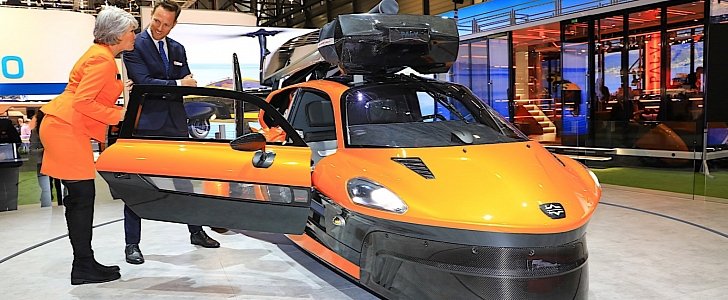The auto industry gave up on the idea of creating a flying car a long time ago. Instead, in recent years, companies like Uber, Airbus, or Audi have begun thinking about more or less autonomous drones as a means to fill the gap between urban land and air mobility.
Not Pal-V, a Dutch company that insists the long-lost dream of creating a flying car can still come true.
Last year, at the Geneva Motor Show, the company brought with it to Palexpo the Liberty gyro-car. This year, the Liberty is back in Geneva, this time as a 90 units limited edition called Pioneer.
Pal-V is a self-stabilizing aircraft that doubles as a car, or the other way around. It uses a dual engine that allows it to reach a top speed of 160 km/h (99 mph) on land or 140 km/h in the air (87 mph, economic cruise speed).
In the Pioneer configuration, the vehicle comes with a full carbon package, a leather interior and two-tone color scheme on the outside.
This Pioneer variant is the one Pal-V hopes will get the company into the history books. The first one they plan to manufacture and deliver, before anything else, even before the base version. A sort of Edition 1, if you like.
A model that has $150,000 worth of extras compared to the standard variant, but sells for $200,000 more, or a total of $600,000.
The machine in itself is undoubtedly a great piece of engineering (and you can have a look at its specs here). As were most other concepts tried before, by others. Granted, most of these other concepts were wing-based, not gyro, but we doubt that will make much of a difference when it comes to the success it will have.
Pal-V says the Liberty “is designed within the current certification and regulations frameworks for the vast majority of countries in the world,” giving the impression that you could use it anywhere, anytime.
The reality of flying a Pal-V is much trickier. You probably won’t be able to take off from wherever you want, say a city street or a stretch of road with wires overhead. The Liberty also needs at least 330 meters of open road (1,082 feet) to take off. And, most of all, you’d need a license - 35 hours of flight training, each worth at least $200.
Pal-V plans to begin manufacturing the Pioneer this year, so we’ll know in no time if the Liberty Pioneer will indeed become the world’s first production flying car.
Last year, at the Geneva Motor Show, the company brought with it to Palexpo the Liberty gyro-car. This year, the Liberty is back in Geneva, this time as a 90 units limited edition called Pioneer.
Pal-V is a self-stabilizing aircraft that doubles as a car, or the other way around. It uses a dual engine that allows it to reach a top speed of 160 km/h (99 mph) on land or 140 km/h in the air (87 mph, economic cruise speed).
In the Pioneer configuration, the vehicle comes with a full carbon package, a leather interior and two-tone color scheme on the outside.
This Pioneer variant is the one Pal-V hopes will get the company into the history books. The first one they plan to manufacture and deliver, before anything else, even before the base version. A sort of Edition 1, if you like.
A model that has $150,000 worth of extras compared to the standard variant, but sells for $200,000 more, or a total of $600,000.
The machine in itself is undoubtedly a great piece of engineering (and you can have a look at its specs here). As were most other concepts tried before, by others. Granted, most of these other concepts were wing-based, not gyro, but we doubt that will make much of a difference when it comes to the success it will have.
Pal-V says the Liberty “is designed within the current certification and regulations frameworks for the vast majority of countries in the world,” giving the impression that you could use it anywhere, anytime.
The reality of flying a Pal-V is much trickier. You probably won’t be able to take off from wherever you want, say a city street or a stretch of road with wires overhead. The Liberty also needs at least 330 meters of open road (1,082 feet) to take off. And, most of all, you’d need a license - 35 hours of flight training, each worth at least $200.
Pal-V plans to begin manufacturing the Pioneer this year, so we’ll know in no time if the Liberty Pioneer will indeed become the world’s first production flying car.





















